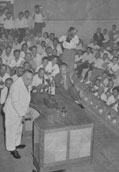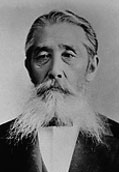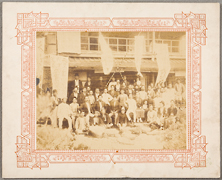HOME > Column > 8 Election Campaign Tours through all ages
Election Campaign Tours through all ages
The busiest time for politicians is when an election is set to take place. Here, let's talk about the history of stumping tours involving politicians, especially leaders of political parties.
On 5 February 1894 (Meiji 27), Liberal Party President ITAGAKI Taisuke departed Tokyo on a stumping tour for the upcoming third general election. He campaigned around for 25 days before returning to Tokyo on 1 March, the day of the election. The itinerary of his campaign tour was detailed in written documents recorded by another Liberal Party politician TATSUNO Shuichiro, who accompanied ITAGAKI on his stumping tour (Papers of TATSUNO Shuichiro). According to the documents, the method of long-distance transport used by politicians during ITAGAKI's era was the steam train, as we might imagine. The only railroad networks in operation in those days were those that are currently considered major railway networks. Each time ITAGAKI arrived at a railway station during the stumping tour, a large crowd of supporters greeted him. ITAGAKI and his supporters rode in rickshaws called "jinrikisha," and drove to venues where he would deliver campaign speeches and hold get-together parties with voters. When he arrived at travel points marking the start of a new county or a new prefecture, ITAGAKI saw temporary green-colored gates (arches made of leaves) that had been erected by the local people. Greeted with smoke and flames, and showered with large-sized flags, ITAGAKI and his party colleagues were led to the place where they were to give their speeches. The venues used for such gatherings in those days were theaters and shrine and temple grounds, where from a few hundred up to as many as three thousand voters would gather to listen to their speeches, each of which usually lasted one hour. During the campaign tour, ITAGAKI traveled nearly about 2,000 kilometers or an average of 80 kilometers each day, mainly covering prefectures in the Tokai and Kansai regions-Shizuoka, Gifu, Kyoto, Osaka, Hyogo, Nara and Mie.

OKUMA Shigenobu making passionate speech. From "Zuroku Okuma Shigenobu" by Waseda University Shuppanbu
16 March 1915 (Taisho 4), Prime Minister OKUMA Shigenobu, at the age of 77, began his campaign tour for the 12th general election to garner support for candidates belonging to his ruling party. But given his old age and infirmity in one leg, combined with the campaign being at the height of World War I, he traveled for only five days, making short train stops in major cities-Osaka, Kanazawa and Nagoya-after leaving Tokyo. After returning to Tokyo, he left the capital again and stopped in Yokohama, before finally swinging back to Tokyo. But Prime Minister OKUMA adopted a unique campaign method during his stumping tour. At each train stop, the Prime Minister delivered a speech from his train window, making this stumping tour so famous that the episode has been told through the generations even down to the present day. Gathered at each station in which he arrived were candidates fielded by OKUMA's ruling party and a large number of their supporters. Making the most of the train's brief two-minute stop, OKUMA pitched his party's candidates by making a speech while protruding his head from the train window. When the train began to leave for the next destination, OKUMA shook hands with the candidate, sparking a loud cheer of "Banzai!" hailing him from the audience. OKUMA repeated this practice each time his train stopped. But it was said that he altered his routine at each station. His travel sometimes involved the use of overnight trains (Okuma-ko 85 nenshi, v.3 (85-year Life of Marquis OKUMA, v.3)Reprint ed. Hara Shobo, 1970). OKUMA's campaign tour in March 1915 (Taisho 4) covered a distance of only about 1,100 kilometers with a daily average of 220 kilometers. During the tour, however, he made numerous speeches, making his campaign activity very effective and efficient.

YOSHIDA Shigeru on election campaign in Kochi. From "Mainichi Gurafu no.134"
Liberal Party President YOSHIDA Shigeru stumped in April 1953 (Showa 28) for the 26th general election. He departed Tokyo on 5 April for a 13-days trip through 17 April, covering a distance of about 2,000 kilometers for a daily average of 150 kilometers. Before returning to Tokyo, he traveled to Nagoya, Mie, Gifu, Toyama, Ishikawa, Fukui, Kyoto, Osaka, Wakayama, Kochi, Takamatsu, Tokushima, Okayama, Hyogo and Kyoto prefectures (Itinerary of election campaign for April 1953 general election , shown in Chapter 6, Papers of ANZAI Shosuke ). YOSHIDA used an airplane for long-distance travel on the stumping tour, flying between Tokyo's Haneda airport and Nagoya, Osaka's Itami airport and Kochi, and finally between Itami and Haneda airports. He also used automobiles effectively for the election campaign, making it possible for him to deliver numerous speeches at elementary schools, public halls and parks in each municipality. However, his speeches were very brief: only about 20 minutes was allotted for each candidate. YOSHIDA, a former diplomat, carried many miscellaneous items during the campaign tour, as he did during his overseas assignments as a diplomat.
For the 22nd House of Councillors election held in July 2010 (Heisei 22), party leaders traveled 9,000 to 17,000 kilometers (an average of 600 to 1,100 kilometers per day) during their 15-days official campaign period, according to news media. Their average daily travel distance increased significantly from the distances seen in previous times, owing to the full use of planes for modern-day campaign tours. Examinations of itineraries of modern-day campaigns seem to show that politicians are repeating round trips between Tokyo and major cities in Japan instead of making circular travel by stopping in particular areas.
At the end of the day, party leaders are still human beings composed of flesh and blood. They try to whip enthusiasm among voters up to the limit of their physical ability, taking into account the transportation means available. Liberal Party leader ITAGAKI deepened his direct interaction with voters by stumping in farming districts and moving together with the local people, although his daily travel distances tended to be short. Prime Minister OKUMA's campaign activity was limited to speeches at railroad stations and public places in major cities. Nevertheless, voters gathered at these places in order to see him. YOSHIDA made direct contact with voters by moving into agricultural areas with the combined use of airplanes and automobiles. But his speeches were shorter than those of ITAGAKI and OKUMA. Since the Heisei era, politicians have flown to large numbers of cities across the nation and tried to feed the frenzy among the people, microphone in hand, despite the limited time available for speeches at each venue. Currently, the number of people each party leader can directly contact during a stumping tour is significantly higher than in the past. At the same time, however, the time available for current-day politicians to fire up the electorate has shortened, which means that they need to do something unique in order to arouse their enthusiasm.


